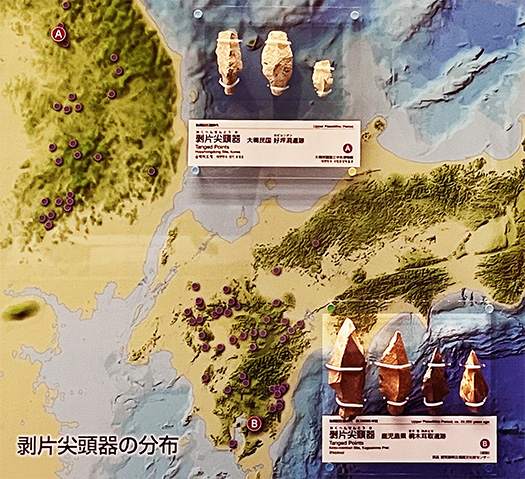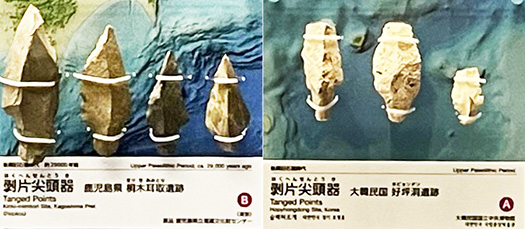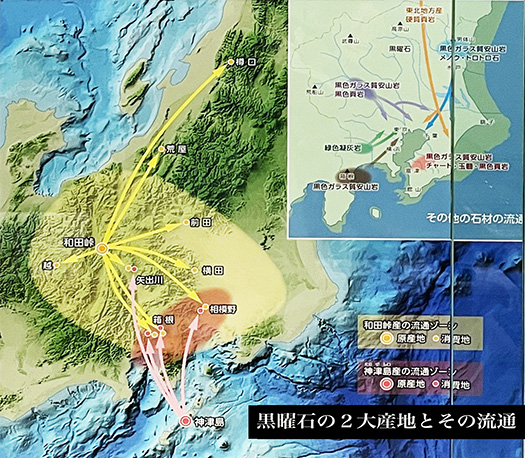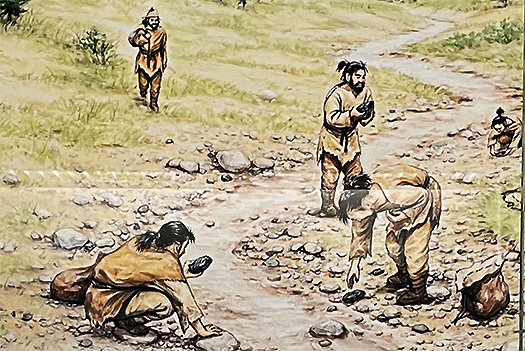

いまから29,000年前、九州を中心に「剥片尖頭器」という槍先が使われた。
発掘の分布状況を見ると九州全域の遺跡で発掘され、一部山口県地方でも。
そして同様の石器は朝鮮半島、主に西側地域で発見されている。
パネル展示では鹿児島県と韓国中西部のものが提示されていた。
はるかな後世の日本と百済の関係を暗示するのかも・・・。
これは旧石器の人々の広域交流の状況を表しているのでしょう。
示されたパネルの地図を見ると日本列島と大陸側・半島との対馬海峡が
非常に狭くなっていることがあきらか。
この29,000年前の時期というのは「最終氷期最寒気」に相当していて
海面が低下し、ほんの少しの距離しか海峡は存在しなかった。
狩猟採集を主な生業としていた旧石器の人々にとっては、
移動というのはきわめて日常的なことだった。
定点的なムラから獲物を求め移動放浪することはよくあっただろう。
そして季節毎に集落自体も移転する生活実態だった。
基本物資である石器さえ確保していれば移動そのものはごく習慣的なことだった。
海を渡って他地域と交流するということにも径庭は小さかった。
海生動物の捕獲ということも大きな目的要因かも知れない。
一方、狩猟道具の一体性からみて血族的関係性も認識していたかもしれない。
人類史ではごく初期から「一夫一婦制」が社会的に採用されたとされる。
当然、血族関係という認識も深く保持していたことも間違いはない。
ほかの動物種と大きく進化が違ったことの有為な起因として
この血族認識は相当大きかったのではないか。
DNAの発展多様性発現にとって有利だったと思われる。・・・
地図では数十キロ程度しか対馬海峡の距離は存在しない。
このあと気候の温暖化から15,000年前以降「縄文海進」の海面上昇があり、
船での移動によってその後も相互関係はあったとしても
基本的には大陸側と相対的に隔絶し独自進化方向に向かったのだろう。


他方、本州中部地域では旧石器時代の最大の利器・天然のガラス「黒曜石」が
長野県にある最大標高1,531mの和田峠と、伊豆半島沖の神津島で産出され、
広域にわたってそれが流通していることが確認されている。
黒曜石は北海道オホーツク海側の白滝で世界最高水準のものが産出される。
こちらも広域に流通していたことがわかっている。
生業での広域移動という要素はさまざまな社会発展のマザーだった。
かなり意図的に知見を相互交流するということが
活発に行われたのが人類であり、その痕跡が精神に強く影響を与えて
やがて抽象的な世界認識や歴史時間認識という不思議な発展に至るのではないか。
石器時代のDNA進化史とでもいえる領域、非常にワクワクする。
English version⬇
Paleolithic: Evolution through Migratory Interaction 37,000 Years of the Japanese Archipelago – 8
Although settlement began after the Jomon period, wide-area migratory exchange since the Paleolithic period has continued as the basis for the “evolution of the information system” of humankind. The evolution of the human race through mobile exchange
29,000 years ago, spear points called “peeled lancets” were used mainly in Kyushu.
The distribution of excavations shows that they have been found at sites all over Kyushu, and some in the Yamaguchi Prefecture area.
And similar stone tools have been found on the Korean Peninsula, mainly in the western region.
The panel display showed items from Kagoshima Prefecture and the central and western parts of Korea.
It may imply a relationship between Japan and Baekje in a far later period….
This may represent the situation of wide-area exchange among the Paleolithic peoples.
Looking at the map on the panel shown, it is clear that the Tsushima Strait between the Japanese archipelago and the continental side and peninsula is very narrow.
The map on the panel clearly shows that the Tsushima Strait between the Japanese archipelago and the continental side and peninsula is very narrow.
This period 29,000 years ago corresponds to the coldest period of the last glacial period.
The sea level dropped and the straits were only a short distance apart.
For Paleolithic people, who were hunter-gatherers as their main livelihood
migration was an extremely common practice.
It would have been common for them to wander from their fixed villages in search of prey.
They also moved from one village to another seasonally.
As long as they had the basic commodity of stone tools, migration itself was a very common practice.
The area was not large enough for people to cross the sea and interact with other areas.
The capture of marine animals may have been a major objective.
On the other hand, they may have been aware of kinship in terms of the unity of their hunting tools.
It is said that “monogamy” was adopted socially from the very beginning of human history.
It is no doubt that the recognition of kinship was also deeply rooted in human history.
This recognition of kinship must have been a significant factor in the evolutionary differences between humans and other animal species.
This recognition of kinship may have been a significant factor in the significant differences in evolution among other animal species.
This is an advantage for the expression of DNA developmental diversity. The map shows only a few dozen kilometers of the
The distance of the Tsushima Strait is only a few tens of kilometers on the map.
After this, there was a sea level rise of “Jomon sea advance” after 15,000 years ago due to the warming of the climate.
Even though there has been a mutual relationship since then due to the movement of ships
The Jomon people were basically separated from the continental side and evolved in their own unique way.
On the other hand, in the central Honshu region, obsidian, the greatest tool of the Paleolithic Age and natural glass, is produced at Wada Pass, the highest point in Nagano Prefecture at 1,531 meters above sea level, and at Kozushima Island off the Izu Peninsula.
The largest source of obsidian, a natural glass of the Paleolithic period, is found at Wada Pass, the highest point in Nagano Prefecture at 1,531 meters above sea level, and at Kozushima Island off the Izu Peninsula.
It has been confirmed that obsidian is distributed over a wide area.
The world’s highest level of obsidian is produced in Shirataki on the Okhotsk Sea side of Hokkaido.
It is known that obsidian was also distributed over a wide area.
The element of wide-area movement for subsistence was the mother of various social developments.
It was quite intentional to exchange knowledge with each other.
The traces of this exchange strongly influenced the psyche, and eventually led to the development of an abstract perception of the world and the creation of a new society.
This may eventually lead to the mysterious development of abstract world awareness and historical time awareness.
This is a very exciting area of DNA evolutionary history of the Stone Age.
Posted on 10月 13th, 2022 by 三木 奎吾
Filed under: 日本社会・文化研究, 歴史探訪







コメントを投稿
「※誹謗中傷や、悪意のある書き込み、営利目的などのコメントを防ぐために、投稿された全てのコメントは一時的に保留されますのでご了承ください。」
You must be logged in to post a comment.